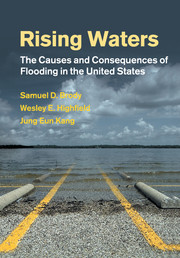Book contents
- Frontmatter
- Contents
- Preface
- Acknowledgments
- Abbreviations
- 1 Introduction: rising waters
- Part I The consequences of floods
- Part II Planning decisions and flood attenuation
- 5 Identifying the factors influencing flooding and flood damage
- 6 The role of wetlands: federal policies, losses, and floods
- 7 Mitigation strategies and reduction of flood damages
- 8 Other factors influencing flooding and flood damage
- Part III What are we learning?
- Part IV Policy implications and recommendations
- 12 Conclusions
- References
- Index
8 - Other factors influencing flooding and flood damage
from Part II - Planning decisions and flood attenuation
Published online by Cambridge University Press: 28 April 2011
- Frontmatter
- Contents
- Preface
- Acknowledgments
- Abbreviations
- 1 Introduction: rising waters
- Part I The consequences of floods
- Part II Planning decisions and flood attenuation
- 5 Identifying the factors influencing flooding and flood damage
- 6 The role of wetlands: federal policies, losses, and floods
- 7 Mitigation strategies and reduction of flood damages
- 8 Other factors influencing flooding and flood damage
- Part III What are we learning?
- Part IV Policy implications and recommendations
- 12 Conclusions
- References
- Index
Summary
The bulk of our book focuses on the effects of wetland alteration and mitigation on flooding and associated flood damages. However, these factors can only be understood within the context of other variables influencing the problem of flooding. In Chapter 5, we identified many of these variables and described their expected influence on flooding and flood loss across the study area.
This chapter presents our empirical findings on the impacts of characteristics we previously treated as contextual control variables: natural environment, built environment, socioeconomic, and political/administrative. Within each category, we systematically discuss the effect of each variable in hopes of providing a broader understanding of the factors contributing to flood problems across the study area.
A distinguishing aspect of our results compared to other studies is that when we describe the individual effects of each contextual variable, we control for a multidisciplinary set of other factors affecting the nature of floods. We also draw conclusions based on multiple models addressing the flooding problem from different angles, thus offering the reader a more comprehensive view of the underlying causes and consequences of coastal flooding in Texas and Florida.
Natural environment
While human interventions can certainly reduce the adverse impacts of floods, their occurrence is largely driven by the natural environment. In most of our explanatory models, geophysical and climate-based factors explain approximately 30% of the variance for both flooding and related flood damage. As expected, precipitation is consistently the most statistically powerful predictor of flooding.
- Type
- Chapter
- Information
- Rising WatersThe Causes and Consequences of Flooding in the United States, pp. 130 - 138Publisher: Cambridge University PressPrint publication year: 2011



